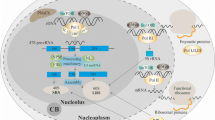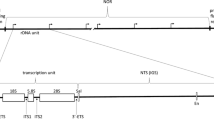Summary
In cells treated with antimetabolites to inhibite RNA- and protein synthesis, electron microscopic studies reveal structural alterations of the nucleolus. The morphological appearance of the nucleolus differs depending of the inhibitor used. If transscription is prevented, segregation of nucleolar components is observed. Inhibition of processing of newly synthesized RNA results in a degranulation and an increase in the amount of nucleolar fibrils. A disturbance of the release of nucleolar ribonucleoproteins into the cytoplasm leads to an enlargement and a hypergranulation of the nucleolus. On the other hand interruption of translation of mRNAs has no immediate effect on the appearance of the nucleolar structure. Only after longer treatment of the cells with the translation inhibitor the nucleolus shrinks and becomes degranulated.
The use of inhibitors with clearly defined mechanisms of action in a morphological study should make it possible to interpret similar nucleolar alterations seen in cancer cells and virus-infected cells on a molecular biological basis.
Zusammenfassung
Wenn man mit Antimetaboliten die RNS- und Proteinsynthese unterbindet, verändert der Nukleolus sein Aussehen. Dabei treten bei der elektronenmikroskopischen Betrachtung ganz unterschiedliche Nukleolusalterationen auf, je nachdem, wo die Synthesekette unterbrochen worden ist. Wenn die Transkription an der DNS gestört ist, kommt es zu einer Trennung der einzelnen Nukleoluskomponenten, zur Segregation. Bei Transformations- (Reifungs-)störungen nehmen die Fibrillen des Nukleolus stark an Zahl zu, die Granula verschwinden dagegen nahezu völlig. Der umgekehrte Vorgang ist zu beobachten, wenn die nukleoläre Stoffabgabe blockiert ist (=Transmissionsstörung): der Nukleolus besteht hier fast nur noch aus Granula und ist stark vergrößert. Translationsstörungen haben keinen unmittelbaren Einfluß auf das Aussehen des Nukleolus. Erst wenn die Bildung der mRNS längere Zeit unterbunden ist, schrumpft der Nukleolus und verarmt an Granula.
Die Kenntnis der morphologischen Nukleolusbefunde nach Gabe von Inhibitoren der RNS-Synthese mit klar definiertem Wirkmechanismus sollte es gestatten, ähnliche Nukleolusveränderungen — etwa bei Krebs- und Virus-infizierten Zellen — auf molekularbiologischer Basis zu deuten.
Similar content being viewed by others
Literatur
Altmann, H.-W.: Über den Funktionsformwechsel des Kernes im exokrinen Gewebe des Pankreas. Z. Krebsforsch.58, 632 (1952)
Altmann, H.-W.: Zur Morphologie der Wechselwirkung von Kern und Zytoplasma. Klin. Wschr.33, 306 (1955)
Altmann, H.-W., Müller, H.-A.: Grundlagen der Karyologie. Verh. Dtsch. Ges. Path.57, 2 (1973)
Bernhard, W., Granboulan, N.: Electron microscopy of the nucleolus in vertebrate cells. In: Ultrastructure in biological systems. Vol. 3: The Nucleus. Ed. by A.J. Dalton and F. Haguenau. Acad. Press New York and London 1968 pp. 81
Bernhard, W., Frayssinet, C., Lafarge, C., Le Breton, E.: Lésions nucléolaires présoces provoquées par l'aflatoxine dans les cellules hépatiques du rat. Comp. Rend.261, 1785 (1965)
Busch, H., Smetana, K.: The Nucleolus. Acad. Press New York and London 1970
Caspersson, T.: Cell growth and cell function. W.W. Norton New York 1950
Craig, N.C., Perry, R.P.: Aberrant intranucleolar maturation of ribosomal precursors in the absence of protein synthesis. J. Cell Biol.45, 554 (1970)
Fiume, L., Wieland, T.: Amanitine. Chemistry and action. Febs Letters8, 1 (1970)
Goldblatt, P.J., Archer, J., Eastwood, C.: The effects of high and low doses of cycloheximide on nucleolar ribonucleic acid synthesis. Lab. Invest.33, 117 (1975)
Heine, U.: Electron microscopic studies on Hela cells exposed to the antibiotic toyocamycin. Cancer Res.29, 1875 (1969)
Journey, L.J., Goldstein, M.N.: Electron microscope studies on Hela Cell lines sensitive and resistant to actinomycin D. Cancer Res.21, 929 (1961)
Kedinger, C., Simard, R.: The action of α-amanitine on RNA synthesis in chinese hamster ovary cells. J. Cell Biol.63, 831 (1974)
Kleinfeld, R.G.: Early changes in rat liver and kidney cells induced by thioacetamide. Cancer Res.17, 954 (1957)
Marinozzi, V., Fiume, L.: Effects of α-amanitin on mouse and rat liver cell nuclei. Exptl. Cell Res.67, 311 (1971)
Miller, O.L., Beatty, B.R.: Nucleolar structure and function. In: Handbook of molecular cytology. North-Holland Res. Monographs Frontiers of Biology.15, 605 (1969)
Philipps, S.G., Phillips, D.M.: Nucleoli of diploid cell strains. Their normal ultrastructure and the effects of toyocamycin and actinomycin D. J. Cell Biol.49, 785 (1971)
Rather, L.J.: Experimental alterations of nuclear and cytoplasmic components of the liver cell with thioacetamide. I. Early onset and reversibility of volume changes of the nucleolus, nucleus and cytoplasm. Bull. Johns Hopk. Hosp.88, 35 (1951)
Romen, W., Bannasch, P.: II. Die Feinstructur des Zellkerns in Hepatocyten und Hepatomzellen der Nitrosomorpholinvergifteten Rattenleber. Virchows Arch. Abt. B. Zellpath.13, 267 (1973)
Romen, W., Knobloch, U., Altmann, H.-W.: Vergleichende Untersuchungen der Kernveränderungen von Rattenhepatocyten nach Actinomycin D- und α-Amanitin-Vergiftung. Virchows Arch. Abt. B Zellpath. in Druck
Simard, R.: The Nucleus: Action of chemical and physical agents. Int. Rev. Cytol.28, 169 (1970)
Simard, R., Bernhard, W.: Le phénomène de la ségrégation nucléolaire: spécificité d'action de certains antimétabolites. Int. J. Cancer1, 463 (1966)
Simard, R., Bernhard, W.: A heat-sensitive cellular function located in the nucleolus. J. Cell Biol.34, 61 (1967)
Stirpe, F., Fiume, L.: Studies of the pathogenesis of liver necrosis by α-amanitine. Effect of α-amanitine on ribonucleic acid synthesis and on ribonucleic acid polymerase in mouse liver nuclei. Biochem. J.105, 779 (1967)
Stöcker, E.: Autoradiographische Untersuchungen zur Deutung der funktionellen Kernschwellung am exokrinen Pankreas. Z. Zellforsch.57, 47 (1962)
Stöcker, E.: Autoradiographische Untersuchungen zur funktionellen und pathologischen Kernschwellung in der Rattenleber nach Fütterung von Thioacetamid. Z. Zellforsch.62, 80 (1964)
Stöcker, E., Altmann, H.-W.: Die Größe des Nucleolus und die Nucleolus-Karyoplasma-Relation als Ausdruck synthetischer Aktivitäten. Z. Krebsforsch.65, 351 (1963)
Tavitian, A., Uretsky, C., Acs, G.: Selective inhibition of ribosomal RNS synthesis in mammalian cells. Biochim. Biophys. Acta.157, 33 (1968)
Unuma, T., Senda, R., Muramatsu, M.: Mechanism of nucleolar segregation-differences in effects of actinomycin D and cycloheximide on nucleolus of rat liver cells. J. Electron Microscopie22, 205 (1973)
Verbin, R.S., Goldblatt, P.J., Farber, E.: The biochemical pathology of inhibition of protein synthesis in vivo. The effects of cycloheximide on hepatic parenchymal cell ultrastructure. Lab. Invest.20, 529 (1969)
Willems, M., Penman, M., Penman, S.: The regulation of RNA synthesis and processing in the nucleolus during inhibition of protein synthesis. J. Cell Biol.41, 177 (1969)
Wünsch, P., Pfeifer, U.: Morphometrische Untersuchungen am Hepatocyten-Nukleolus der Ratte bei Hunger und Wiederfütterung. In Vorbereitung
Author information
Authors and Affiliations
Rights and permissions
About this article
Cite this article
Romen, W., Altmann, H.W. Die Struktur des funktionsgestörten Nukleolus. Klin Wochenschr 55, 563–567 (1977). https://doi.org/10.1007/BF01490508
Issue Date:
DOI: https://doi.org/10.1007/BF01490508
Key words
- Structure of the nucleolus
- Inhibition of the RNA- and protein synthesis
- Correlation of nucleolar structure and function




